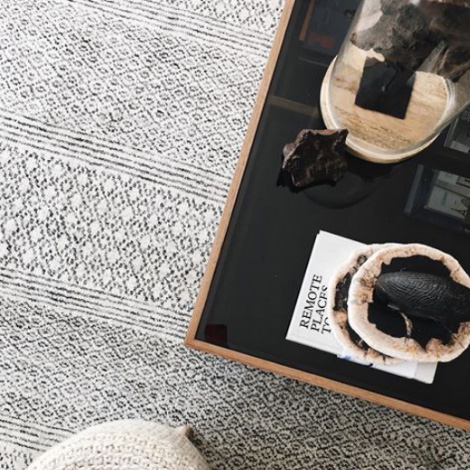Suddenly, it seems like modern is having a moment. Jaipur Living gets the design industry scoop from interior designer and creative director Jessica Davis.

The Jaipur Wunderkammer collection is a collaboration made in modern motif heaven between Jaipur Living and designer Matteo Cibic.
According to Davis, principal designer of Atelier Davis and founder of innovative hardware brand Nest Studio, a lot of this can be attributed to social media. “It’s made design more democratic,” she says. “You see influencers designing modern homes and maybe you realize it’s something you can do too.”
See also: 4 Ways To Elevate Interiors With Unconventional Materials
From social media also comes a desire for the mix, and Davis says that makes modern design more approachable than in years past. “Modern design doesn’t have to be austere or stark. You can mix modern architecture with traditional furnishings, or throw in modern accessories. It’s not all or nothing anymore.”

The bestselling Genesis collection is a study in abstract motifs.
One of the key motifs of modern design is abstract, a fluid term that’s a catch all of sorts for anything outside of representational, defined forms (think flowers). When it comes to abstract, it’s lines, dots, squiggles, curves, geometrics, and such, which give modern design its personality. Davis says abstract is so closely associated with modern design because “modernism is all about clean lines and form. Naturally, geometric shapes and the idea of abstracted forms play on that.”
See also: 3 Steps To Mastering The Trend: Urban Curator
Nailing abstract motifs can be tricky, but if done right, it can be extremely impactful, giving a room an elegant, inspiring touch. Here’s how to pull it off; plus, what’s trending and where design often goes wrong.

The Iconic collection from Jaipur Living brings modern, geometric patterns to life.
How to Pick an Abstract Motif
For Davis, the process starts with thinking about each surface in the room as a canvas. These can be large decisions, such as tile, or smaller ones, such as pillow fabric. She considers abstract motifs such as geometric rugs or wallpaper to ground the room and give it personality. “I love how rugs in particular can weave shapes together and create new and interesting patterns and motifs with overlapping shapes,” she says, noting that this is also applicable to textiles. Next, she likes to layer in 3D items, such as an interestingly-shaped sofa or pouf to add a bit of softness.
When it comes time to choose a motif, Davis relies on scale first and foremost, plus what is going on in the rest of the room. Sometimes a motif is her starting point and for others it’s a finisher. “You can go colorful or monochromatic, but it’s important to think about the scale of the motif and the scale of any motifs it’s playing against, such as a rug versus sofa upholstery versus wallpaper,” she says. “You don’t want them to compete.”
Color plays a large part in tying your motifs together in a single room. “It’s the perfect way to tie motifs together,” she explains. “For example, maybe you have a floral wallpaper and you can pull out one of the colors from that into a checked pillow or abstract watercolor-style rug.” As for how to mix motifs, she brings it back to scale—having the right scale in any prints or items will make a room visually appealing without overwhelming it.
Davis checks her work once she’s done placing everything to make sure it fits what she’s going for, whether that be swatches or physically placing items in a room. “The key is really to scale everything correctly,” she restates. “Then you can really see what pops and what doesn’t.”
See also: 8 Questions On The Truth About Textiles
While the default might be to find modern and abstract motifs in rugs and wallpaper, Davis says not to discount other sources of visual interest, such as upholstery and lighting. “Think interesting, squiggly shapes, or wacky tufting,” she says. “And don’t forget about art!”
If you’re looking for inspiration on where to start with an abstract motif, Davis has been seeing a lot of brushstrokes and “what I’ll call Rorschach inkblot motifs,” she says. “I especially like the ink blots as wallpaper or centered on a chair back. These are cool if done well.” She advises that motifs such as those that are on the busier side work well in smaller doses and items, such as pillows, or spaces where you can have more high-impact but don’t need to visually see them all the time, like powder room walls.
As for what she’s personally into? “I love a good wavy line these days,” she says, “whether on a piece of furniture, the handle of a vase, or an upholstered headboard.” She’d like to try out checkerboards at some point as well, but clarifies she’s interested in nontraditional, nonblack-and-white design. “I like modern, colorful checks in bold brights,” she says.

The Citrine collection from Jaipur Living is the ideal of traditional-leaning motifs that have been reimagined in a modern style.
A Common Mistake in Using Abstract Motifs
It can be easy to get swept up in the sensuality of modern motifs, but Davis advises not overdoing it and running out to match your sofa motif to your rug motif. She cautions against being overly matchy in general. “You want to repeat elements,” she says, “but I think modernism and abstract motifs work best when mixed with other things. They should be different but involved in the same conversation,” she says.

The Nagaland Throws are are handmade by weavers in Nagaland, India, using traditional loin-loom techniques.
Get the Look: Davis’ Abstract Motif Picks
Next story







